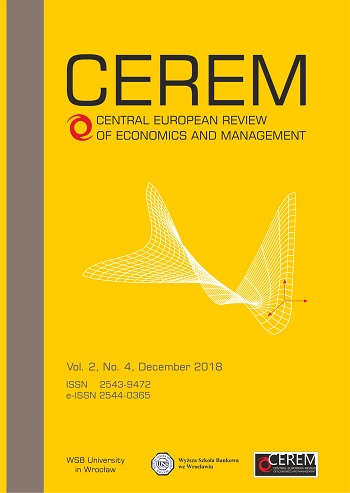Central counterparties – risk minimizers?
DOI:
https://doi.org/10.29015/cerem.594Słowa kluczowe:
central counterparties, central clearing obligation, systemic risk, risk management, crisis, too big to failAbstrakt
Aim: Recently, central counterparties (CCPs) have gained on popularity due to their positive impact on the financial markets during crisis (limiting contagion on cleared instruments). The post-crisis reforms favored CCPs as risk minimizers. The aim of the article is to critically assess the functioning of the CCPs and their role in the financial system.
Design / Research methods: In order to attain the article’s goal, the critical analysis of the CCPs’ activity was performed. For that purpose, the regulations and mechanisms for CCPs’ functioning were considered. The next step was the analysis of the scale of CCPs’ activity and dependencies between CCPs and various market participants based on the accessible data. Based on the desk research and content analysis, the risks of CCPs were derived.
Conclusions / findings: CCPs are not risk minimizers, but they are risk managers (redistributors). Moreover, due to the significant increase in the their importance for the stable functioning of the financial markets, they should be treated as too big to fail institutions.
Originality / value of the article: The literature, especially polish, regarding the assessment of the CCPs’ roles and functions is relatively scarce, especially concerning the potential dangers conneted with them. The article contains the unbiased assessment of CCPs’ impact on the financial markets and proposes inventive treatment of CCPs as risk redistributors, which are too big to fail.
Bibliografia
BIS, FSB, OICU-IOSCO (2017) Analysis of Central Clearing Interdependencies https://www.iosco.org/library/pubdocs/pdf/IOSCOPD570.pdf (accessed 25.10.2017)
Chande N., Labelle N., Tuer E. (2011) Central counterparties and Systemic Risk, Bank Of Canada Financial System Review
Czapiewski P. (2010) Wybrane uproszczenia w modelach oceny poziomu ryzyka instrumentów finansowych prowadzące do niedoszacowania stopnia tego ryzyka in: (red.) R. Bartkowiak, J. Ostaszewski (2010) Nauki ekonomiczne w świetle nowych wyzwań gospodarczych, Oficyna Wydawnicza SGH
DnB (2013) All the Ins & Outs of CCPs, https://www.dnb.nl/en/binaries/711869_All_Ins_Outs_CCPs_EN_web_v3_tcm47-288116.pdf (accessed 25.10.2017)
European Commission (2016) Safe Financial Infrastructure, https://ec.europa.eu/info/system/files/ccp-proposal-factsheet-28112016_en.pdf (accessed 25.10.2017)
European Commission (2017) COMMUNICATION FROM THE COMMISSION TO THE EUROPEAN PARLIAMENT, THE COUNCIL AND THE EUROPEAN CENTRAL BANK Responding to challenges for critical financial market infrastructures and further developing the Capital Markets Union, http://eur-lex.europa.eu/legal-content/EN/TXT/?uri=CELEX:52017DC0225 (accessed 25.10.2017)
Fleming M., Sarkar A., 2014, The Failure Resolution of Lehman Brothers, FRBNY Economic Policy Review / December
G20 (2009) G20 Leaders Statement: The Pittsburgh Summit, http://www.g20.utoronto.ca/2009/2009communique0925.html (accessed 25.10.2017)
Greenwich Associates (2015) Systemic Risk and the Impacts of Central Clearing, Greenwich Report
Heath A., Gerard K., Manning M. (2015) Central Counterparty Loss Allocation and Transmission of Financial Stress, Research Discussion Paper 2015-02, Reserve Bank of Australia
Hermans L., McGoldrick P., Schmiedel H. (2013) Central counterparties and systemic risk, ESRB Macroprudential Commentaries Issue No. 6
Koleśnik J. (2014) Role of public institutions and their strategies in crises events in 2008-2010, Finanse Czasopismo Komitetu Nauk o Finansach PAN No 1(7) 2014, Komitet Nauk o Finansach PAN
Niedziółka P. (2009) Kredytowe instrumenty pochodne a stabilność finansowa, Oficyna Wydawnicza SGH
Norman P. (2011) The risk controllers, John Wiley & Sons Ltd
Pirrong C. (2011) The Economics of Central Clearing: Theory and Practice, ISDA Discussion Papers Series May
Pruchnicka-Grabias I. (2011) Pochodne instrumenty kredytowe. Systematyka, wycena, zastosowanie, CeDeWu
Regulation (EU) No 648/2012 of the European Parliament and of the Council of 4 July 2012 on OTC derivatives, central counterparties and trade repositories (EMIR Regulation)
Rehlon A., Nixon D. (2013) Central counterparties: what are they, why do they matter and how does the Bank supervise them?, http://www.bankofengland.co.uk/publications/Documents/quarterlybulletin/2013/qb1302ccpsbs.pdf (accessed 25.10.2017)
Ślązak E. (2012) Theoretical grounds for the use of the public policies in: (red.) M. Wieger (2012) Development per public policy support in the food economy - the example of Poland, Instytut Ekonomiki Rolnictwa i Gospodarki Żywnościowej
Wendt F. (2015) Central Counterparties: addressing their Too Important to Fail Nature, IMF Working Paper WP/15/21
Zaleska M. (2015) Refleksje na temat unii rynków kapitałowych” in A. Janc, P. Mikołajczak, K. Waliszewski: (2015) „Europejska unia rynków kapitałowych. Perspektywa finansowania przedsiębiorstw w Polsce”, CeDeWu
[www 1] https://www.esma.europa.eu/regulation/post-trading/non-financial-counterparties-nfcs (accessed 25.10.2017)
[www 2] https://www.opengamma.com/2016/07/05/25-increase-in-cleared-swaps-initial-margin-in-the-5-days-since-brexit/ (accessed 03.11.2017)
[www 3] http://www.theotcspace.com/2015/10/02/clear-or-not-clear-directly-question (accessed 3.11.2017)
Pobrania
Opublikowane
Numer
Dział
Licencja
Autor przenosi nieodpłatnie na Wyższą Szkołę Bankową we Wrocławiu , bez ograniczeń terytorialnych, majątkowe prawa autorskie do tego utworu w rozumieniu ustawy z dnia 4 lutego 1994 roku o prawie autorskim i prawach pokrewnych ( Dz.U. 1994, Nr 24, poz. 83 ze zm. )na zasadzie wyłączności, tj. prawo do:
a) wyłącznego używania i wykorzystania utworu w dowolnej działalności przez Wyższą Szkołę Bankową we Wrocławiu, w szczególności w działalność Biblioteki Cyfrowej uruchomionej przez Wyższą Szkołę Bankową we Wrocławiu
b) wytwarzania, utrwalania i zwielokrotniania egzemplarzy utworów wszelkimi technikami, w tym techniką drukarską, reprograficzną, zapisu magnetycznego oraz techniką cyfrową, w szczególności ich zwielokrotniania poprzez dokonywanie zapisów na płytach typu CD,
c) zamieszczenia wybranych fragmentów utworu w celach promocyjnych w publikacjach, materiałach promocyjnych, w sieci Internet oraz sieciach wewnętrznych typu Intranet Wyższej Szkoły Bankowej we Wrocławiu,
d) wprowadzania utworu do pamięci komputera Wyższej Szkoły Bankowej we Wrocławiu,
e) kopiowania i powielania utworu w technologiach fotomechanicznych lub innych znanych w dniu zawarcia umowy (fotokopie, kserokopie itp.),
f) przetworzenia dzieła na formę elektroniczną i nieograniczonego rozpowszechniania w sieci Internet.


